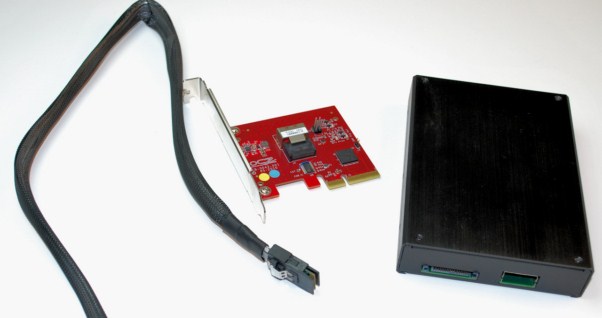OCZ IBIS HSDL Solid State Drive Preview
The OCZ IBIS Up Close



Silicon Image PCI/PCI-X Hardware RAID Controller and a Pericom PCI Express to PCI-X Bridge?
There are three primary circuit boards that make-up the 240GB IBIS drive we tested; two Flash memory SSDs with a pair of SandForce 1222 SSD controllers per card (4 total) and a single controller card with a Silicon Image Steel Vine hardware-based RAID controller.

Silicon Image Steel Vine and companion Pericom Bridge
The Silicon Image 3124 RAID controller is actually a 4-port PCI-X to 3Gps SATA host controller, if you can believe that. The chip next to it (top right) is a Pericom PCI Express to PCI/PCI-X reversible bridge. To be honest, when we stopped to think of all the bridging going on here (PCIe to PCI-X and PCI-X to 3G SATA) it raised our hackles a bit. However, the fact of the matter is it just works and this is a hardware-based on-board RAID solution that OCZ determined was economical and able to provide enough bandwidth, while somehow hiding latency. We questioned OCZ on the use of the Steel Vine PCI/PCI-X chip and they offered this in reply:
"We viewed this controller as fast enough and do not see it as a bottleneck. PCI-X actually has quite a bit of headroom and will go to 1000MB/sec which isn’t considered slow and both PCI-X DDR and QDR posed serious threats to PCI-Express as a bus. While the industry went PCI-Express over “X”, the technology is still very viable and though it may be “older” it is not necessarily slower. There is some minor latency with a two chip solution but it is not noticeable in benchmarks, as the timing of the flash is not that quick, in terms of real-world performance it [latency] is definitely not noticeable."
The other chip you might be wondering about in this design is the small blacked-out chip that resides on the X4 PCI Express HBA. We're told this is a chip made by semiconductor manufacturer PLX. PLX is known for its high performance PCI Express Switch chips that are utilized on motherboards and even graphics card designs, to fan out PCI Express lanes for additional connectivity and expansion. Likely this chip is offering low-latency cut-through switching from the HSDL lanes coming in over the SAS cable here, to the PCI Express X4 edge connector on the IBIS adapter card.
All told, to be completely honest, the design does look a bit kludgy to us. The engineers at OCZ might cringe on that word but it is what it is. Let's face it, there are a lot of interfaces at play here and plenty of bridging going on. However, the fact of the matter is, though the design isn't completely elegant, it gets the job done nicely, as you'll see in the benchmark numbers we have for you on the following pages.







